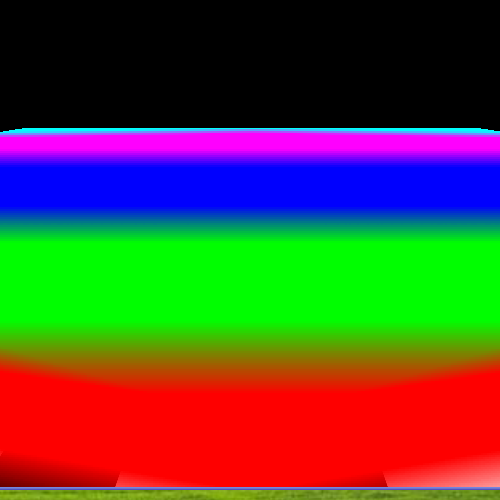ATI's Late Response to G70 - Radeon X1800, X1600 and X1300
by Derek Wilson on October 5, 2005 11:05 AM EST- Posted in
- GPUs
High Quality AF
One of the greatest things about the newest high end hardware from NVIDIA and ATI is that advanced filtering features can be enabled at any resolution while still maintaining playable framerates. It may take developers a little while to catch up to the capabilities of the X1800 and 7800 lines, but adding value through advanced quality features is definitely a welcome path for ATI and NVIDIA to take. For this launch, ATI has improved their AA and AF implementations. We also have two brand new features: Adaptive AA and Area Anisotropic filtering.
Starting with Area Anisotropic (or high quality AF as it is called in the driver), ATI has finally brought viewing angle independent anisotropic filtering to their hardware. NVIDIA introduced this feature back in the GeForce FX days, but everyone was so caught up in the FX series' abysmal performance that not many paid attention to the fact that the FX series had better quality anisotropic filtering than anything from ATI. Yes, the performance impact was larger, but NVIDIA hardware was differentiating the Euclidean distance calculation sqrt(x^2 + y^2 + z^2) in its anisotropic filtering algorithm. Current methods (NVIDIA stopped doing the quality way) simply differentiate an approximated distance in the form of (ax + by + cz). Math buffs will realize that the differential for this approximated distance simply involves constants while the partials for Euclidean distance are less trivial. Calculating a square root is a complex task, even in hardware, which explains the lower performance of the "quality AF" equation.
Angle dependant anisotropic methods produce fine results in games with flat floors and walls, as these textures are aligned on axes that are correctly filtered. Games that allow a broader freedom of motion (such as flying/space games or top down view games like the sims) don't benefit any more from anisotropic filtering than trilinear filtering. Rotating a surface with angle dependant anisotropic filtering applied can cause noticeable and distracting flicker or texture aliasing. Thus, angle independent techniques (such as ATI's area aniso) are welcome additions to the playing field. As NVIDIA previously employed a high quality anisotropic algorithm, we hope that the introduction of this anisotropic algorithm from ATI will prompt NVIDIA to include such a feature in future hardware as well.
We sat down with the D3DAFTester to show the difference between NVIDIA and ATI hardware with and without the high quality mode enabled. Here's what we ended up with:
One of the greatest things about the newest high end hardware from NVIDIA and ATI is that advanced filtering features can be enabled at any resolution while still maintaining playable framerates. It may take developers a little while to catch up to the capabilities of the X1800 and 7800 lines, but adding value through advanced quality features is definitely a welcome path for ATI and NVIDIA to take. For this launch, ATI has improved their AA and AF implementations. We also have two brand new features: Adaptive AA and Area Anisotropic filtering.
Starting with Area Anisotropic (or high quality AF as it is called in the driver), ATI has finally brought viewing angle independent anisotropic filtering to their hardware. NVIDIA introduced this feature back in the GeForce FX days, but everyone was so caught up in the FX series' abysmal performance that not many paid attention to the fact that the FX series had better quality anisotropic filtering than anything from ATI. Yes, the performance impact was larger, but NVIDIA hardware was differentiating the Euclidean distance calculation sqrt(x^2 + y^2 + z^2) in its anisotropic filtering algorithm. Current methods (NVIDIA stopped doing the quality way) simply differentiate an approximated distance in the form of (ax + by + cz). Math buffs will realize that the differential for this approximated distance simply involves constants while the partials for Euclidean distance are less trivial. Calculating a square root is a complex task, even in hardware, which explains the lower performance of the "quality AF" equation.
Angle dependant anisotropic methods produce fine results in games with flat floors and walls, as these textures are aligned on axes that are correctly filtered. Games that allow a broader freedom of motion (such as flying/space games or top down view games like the sims) don't benefit any more from anisotropic filtering than trilinear filtering. Rotating a surface with angle dependant anisotropic filtering applied can cause noticeable and distracting flicker or texture aliasing. Thus, angle independent techniques (such as ATI's area aniso) are welcome additions to the playing field. As NVIDIA previously employed a high quality anisotropic algorithm, we hope that the introduction of this anisotropic algorithm from ATI will prompt NVIDIA to include such a feature in future hardware as well.
We sat down with the D3DAFTester to show the difference between NVIDIA and ATI hardware with and without the high quality mode enabled. Here's what we ended up with:
NVIDIA 7800 GTX AF
NVIDIA 7800 GTX AF
Mouse over to cycle images












103 Comments
View All Comments
Madellga - Wednesday, October 5, 2005 - link
In the recent past very few sites had benchmark at 1920x1200 (behardware had it for the GTX launch). I would like to see this included in the future. Dell 2405FP is more popular than the Apple 30".I can see the cards available for order at overclockers.co.uk, but they are very expensive. XL ships next week, XT after Nov. 10th.
Does the new ATI has shimmering problems similar to the 7800 line?
bob661 - Wednesday, October 5, 2005 - link
Can you buy these? None on Newegg or ZZF.bldckstark - Wednesday, October 5, 2005 - link
NO! RTFA or RTFF, its listed on the first page of the article.